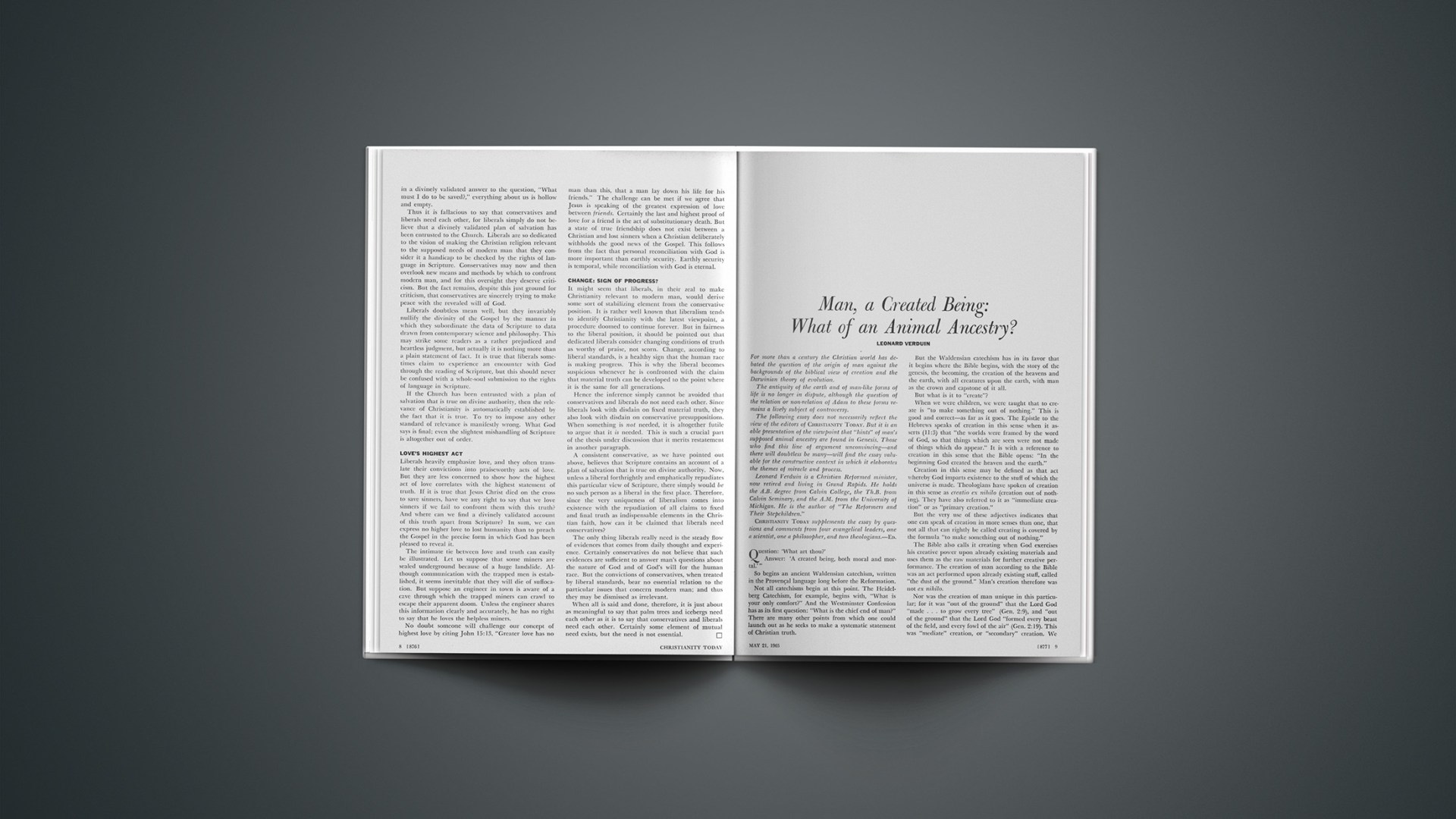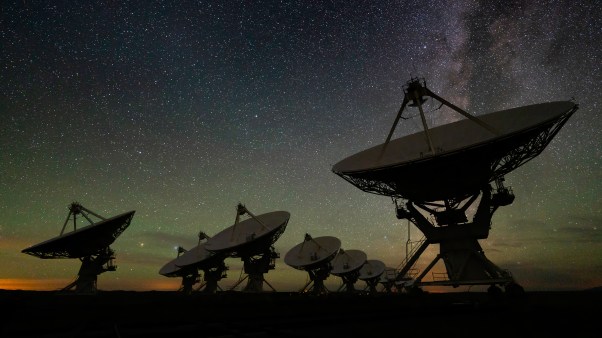For more than a century the Christian world has debated the question of the origin of man against the backgrounds of the biblical view of creation and the Darwinian theory of evolution.
The antiquity of the earth and of man-like forms of life is no longer in dispute, although the question of the relation or non-relation of Adam to these forms remains a lively subject of controversy.
The following essay docs not necessarily reflect the view of the editors of CHRISTIANITY TODAY. But it is an able presentation of the viewpoint that “hints” of man’s supposed animal ancestry are found in Genesis. Those who find this line of argument unconvincing—and there will doubtless be many—will find the essay valuable for the constructive context in which it elaborates the themes of miracle and process.
Leonard Verduin is a Christian Reformed minister, now retired and living in Grand Rapids. He holds the A.B. degree from Calvin College, the Th.B. from Calvin Seminary, and the A.M. from the University of Michigan. He is the author of “The Reformers and Their Stepchildren.”
CHRISTIANITY TODAY supplements the essay by questions and comments from four evangelical leaders, one a scientist, one a philosopher, and two theologians.—ED.
Question: ‘What art thou?’
Answer: ‘A created being, both moral and mortal.’”
So begins an ancient Waldensian catechism, written in the Provencal language long before the Reformation.
Not all catechisms begin at this point. The Heidelberg Catechism, for example, begins with, “What is your only comfort?” And the Westminster Confession has as its first question: “What is the chief end of man?” There are many other points from which one could launch out as he seeks to make a systematic statement of Christian truth.
But the Waldensian catechism has in its favor that it begins where the Bible begins, with the story of the genesis, the becoming, the creation of the heavens and the earth, with all creatures upon the earth, with man as the crown and capstone of it all.
But what is it to “create”?
When we were children, we were taught that to create is “to make something out of nothing.” This is good and correct—as far as it goes. The Epistle to the Hebrews speaks of creation in this sense when it asserts (11:3) that “the worlds were framed by the word of God, so that things which are seen were not made of things which do appear.” It is with a reference to creation in this sense that the Bible opens: “In the beginning God created the heaven and the earth.”
Creation in this sense may be defined as that act whereby God imparts existence to the stuff of which the universe is made. Theologians have spoken of creation in this sense as creatio ex nihilo (creation out of nothing). They have also referred to it as “immediate creation” or as “primary creation.”
But the very use of these adjectives indicates that one can speak of creation in more senses than one, that not all that can rightly be called creating is covered by the formula “to make something out of nothing.”
The Bible also calls it creating when God exercises his creative power upon already existing materials and uses them as the raw materials for further creative performance. The creation of man according to the Bible was an act performed upon already existing stuff, called “the dust of the ground.” Man’s creation therefore was not ex nihilo.
Nor was the creation of man unique in this particular; for it was “out of the ground” that the Lord God “made … to grow every tree” (Gen. 2:9), and “out of the ground” that the Lord God “formed every beast of the field, and every fowl of the air” (Gen. 2:19). This was “mediate” creation, or “secondary” creation. We shall therefore have to label the old definition “to make something out of nothing” as inadequate, or not sufficiently sophisticated.
It will serve us no good purpose to hesitate or hang back at this point. Too often and too long have men imagined that the cause of Christianity is served by restricting the concept of creation to creatio ex nihilo.
Creatio ex nihilo is thinkable only to the man who really believes that God is a transcendent being, able to take his position over and above and beyond all created forms of existence. But to believe in the transcendence of God is not enough; biblical orthodoxy quite as certainly requires a belief in the immanence of God. The orthodox position is that God is at one and the same time immanent and transcendent. The God of the Bible works from without and from within.
A theology in which the idea of transcendence is predominant is deism, and a theology built on the idea of immanence is pantheism. Authentic Christianity, the Christianity of the Bible, does not choose between the two but accepts the one as unreservedly as the other. The resulting position is called theism. It alone promotes genuinely Christian habits of thought.
Although this comes as a surprise to those who have been conditioned by a more or less deistic tradition, the Bible is not afraid of the idea of immanence. The Apostle Paul says without the slightest hesitation that it is “in God” that men, all men, “live, and move, and have [their] being” (Acts 17:28). Nor is the Genesis account at all hesitant to introduce the idea of God working “from within.” What else can be the intent of the inspired report of the creative words, “Let the earth bring forth grass, the herb yielding seed …” (Gen. 1:11)? Or, of “Let the waters bring forth abundantly the moving creature that hath life, and … great whales … which the waters brought forth abundantly” (Gen. 1:20, 21)? Or, “Let the earth bring forth … cattle, and creeping thing, and beast of the earth” (Gen. 1:24)?
It would seem that the creative act of God seen from the vantage point of his transcendence has the dimension of the sudden, the catastrophic, the cataclysmic, the irruptive (this word, which we shall have occasion to use again and which is to be carefully distinguished from “eruptive,” is derived from two Latin words, meaning “in” and “burst” or “break,” so that the meaning is in-breaking or in-bursting, the non-processional, the ictic (this word, which was once in common use and which we shall be using freely, is from a Greek stem meaning “stroke” or “blow,” so that “ictic” stands for that which comes like a hammer-blow, sudden and unannounced).
It would seem, moreover, that the creative act of God seen from the vantage point of his immanence has the dimension of the drawn-out, the processive, the gradual, the progressive, the time-consuming.
It would seem, finally, that the creative act seen in the light of God’s transcendence is immediate creation, whereas the creative act seen in the light of God’s immanence is mediate creation.
A glance at the Genesis account shows very clearly that the inspired writer had no desire whatsoever to keep the idea of process and of progress out of the narrative. He manifestly did not think that the idea of process was foreign to the creationism he was promoting. Far from it. He deliberately introduced the idea of the drawn-out. Nothing seems to have been farther from his intention than the idea of a Mighty Creator bringing all creaturedom into existence by a snap of the fingers as it were. The very idea of six consecutive units of creative activity, following the one upon the other as days and nights follow each other in orderly procession, puts us squarely in the climate of the processive, the gradual, the non-ictic. Moreover, such language as the following suggests the idea of process rather than the idea of irruption: “Let the earth bring forth.… Let the waters bring forth.” If the figure is permissible, the writer of Genesis thought of the creating hand not simply as a hand that snaps a finger and, lo, there it is, but quite as much as a hand that molds and makes, with the prodigal disregard for the passing of time that marks the hand of him who fashions a work of art.
When in the nineteenth century the theory of evolution was being popularized, Christianity, especially Christianity in the New World, was suffering from overemphasis upon the irruptive. In fact, the orthodoxy of those times doted on the non-processive. Men got very close to saying, indeed did say, that the Christian religion begins at the point where the processive ends and the irruptive begins. Essentially deistic in its emphases, the orthodoxy of those times imagined that only ictic materials could be used in the building of the house of God. It had an eye for God’s acts from without and correspondingly little eye for his acts from within.
In its zest for the irruptive, this orthodoxy looked upon the Bible as the Great Irruption, a something that had fallen, as it were, from heaven, with little reference to the historic process. Little did men realize that in so stressing the irruptive they were getting dangerously close to the theology of the pagan Ephesians, who also had an object, the image of Diana, which, so it was held, had hurtled upon them out of heaven. This orthodoxy was hardly prepared to allow that the Bible is the product of history. This orthodoxy pictured salvation as simply a series of divine interventions, as wholly the result of a series of invasions of supernatural power. It was relatively blind to the fact that the work of God is also in the pattern of “first the blade, then the ear, after that the full corn in the ear” (Mark 4:28). Christian nurture was minimized as a device useful in the making of the children of God—it was too processive for that. In fact, it may be said that in such orthodoxy, history and the historical process are rather much of a farce. The Son of God did not use history; he came to terminate it. His whole enterprise was supernatural in the most literal sense, above nature. So this brand of orthodoxy held.
It has been said that every heresy that raises its head to plague the Church of Christ reflects one of the Church’s unpaid bills. When the Church commits the sin that someone has called “the sin of emphasis,” there is bound to be in the making a reaction to it—which will then pose a new heresy. There is a world of truth in this. The deistic emphasis of which we have spoken was bound to call forth protest, angry protest. In this way it became the mother of a new heresy.
The German poet Goethe, sometimes called “the first modern man,” led such a reaction, rebelling with all his strength of soul—which was considerable—against the essentially deistic theology of his day. Hear him in one of his tirades against it:
War wär’ ein Gott der nur von aussen stiesse?
Das All im Kreis am Finger laufen liesse?
Ihm ziemt’s die Welt von inneren zu bewegen
Natur in sich, sich in Natur zu hegen!
(What kind of God is this that only pokes at things;
And lets the universe spin round His finger?
His business is to run the world from the inside
Make nature in himself, himself in nature to abide.)
This is sheer pantheism, of course; but it is an understandable protest against a theology that had become hopelessly entangled in a deistic life-and-world view. Goethe left no room for the irruptive act of God, no room for the miracle, no place for the supernatural—without which Christianity cannot exist; but Goethe’s heresy reflected an unpaid bill of the Christian orthodoxy he had inherited.
Among the theologians in the New World it was Horace Bushnell who led the fight against a Christianity that had invested its all in the irruptive. His book entitled Christian Nurture, a book that shook the theological world in its day, was a plea for Christianity in the signature of process, so much so that his opponents accused him of advocating “vegetable Christians.” Before Bushnell had run his course, he had no real place left for any irruptive act of God, no room for miracle, for anything supernatural. Bushnell had the Almighty as firmly locked up in the creatural order as Goethe had wanted him to be. Bushnell in this way became the father of the modernism that is now, happily, on the defensive.
Alert theologians of Bushnell’s day realized full well that a revolution was taking place. Led by such men as Bennet Tyler they accused Bushnell of scrapping authentic Christianity—which, as they were convinced, is a religion of the irruptive, or, as they preferred to put it, of the ictic. Under the influence of the new theology of process, regeneration, hitherto looked upon as the result of an invasion of supernatural power, now became the mere precipitate of the educative process; the Bible, hitherto held to be the result of an ictic act of God, now came to be thought of as wholly factorable out of the historic process; the very person of Christ, hitherto treated as the master invasion into history, came to be looked upon as the precipitate of the historic situation; conversion, formerly dealt with as an irruptive thing, now came to be identified with the phenomena attending adolescence. In the Bushnellian system the very idea of the Second Coming, hitherto celebrated as the final irruption, was reduced to the dimension of the process. And so on.
Against this modernism for which Bushnell had prepared the way, there was a reaction known as fundamentalism. Since it was itself a reaction, it was from the start in danger of over-correcting the evil it rose to rebuke, of flying again into the arms of pure icticism. That it did not wholly escape this danger is now quite clear. The fundamentalism of which we speak was natively happy in the presence of the ictic and natively ill at ease in the presence of the processive. It sought once again to attain to orthodoxy by playing in one and only one register—that of the supernatural, the non-processive. Typical of it was the large place it assigned to the idea of the Second Coming, looked upon as in no sense the fruition of the historic process but as something brought about simply and solely by the interrupting voice of God.
Need it be pointed out that any theology that lays a one-sided emphasis on the ictic will be inclined to restrict the concept of creation to immediate creation and will tend to think that process and creation are mutually exclusive?
Is it at all surprising that in the tradition of modernism the idea of evolution, as worked out in the late nineteenth and early twentieth century, came in as a flood? It fit perfectly into modernism’s master formula, that of process. And need we be surprised that fundamentalism was unable to find a grain of truth in evolutionism? Fundamentalism’s theology in the signature of irruption precluded that.
Needless to say, there was no dialogue between the two camps. They were too mutually exclusive for that. Fundamentalists talked about the modernists but not with them. And conversely, modernists talked about the fundamentalists (the “fundies”) but not with them. The two groups were too disparate for fruitful dialogue. (There are hopeful signs that in this matter things are better than they were.)
We have noted that God was creating mediately when he made man and did so with recourse to already existing stuff. The Bible says that this stuff was “dust”—for we read: “The Lord God formed man of the dust of the ground,” and there is added, “and breathed into his nostrils the breath of life; and man became a living soul” (Gen. 2:7).
But what was this “dust”?
It is hardly in keeping with the lofty tenor of the Genesis account to conjure up the picture of Deity stooping down to scoop up a shovelful of pulverized earth, adding the necessary liquid to bind it together, then kneading it into shape, with groins and ridges, eye sockets, and a protuberance with nostrils in it into which the Almighty then blew a puff of air, so concluding the experiment. This is out of keeping with the primitive dignity of the Genesis story.
How did the word “dust” get into the story? We submit that it was by way of a Hebrew fondness for circular representation. One finds among the Hebrew poets of the Bible an often recurring fondness for beginning at a point and then returning to it after a circuit has been made. In Amos we read, for instance, that God calls the waters of the sea, pours them out on the earth, whence they flow back to the sea from which they had come, so completing the circular voyage. We read of the sun rising in the east, riding as a chariot across the heavens, setting in the west, and then, while men are asleep, hastening to the place from which it rose, so scribing a perfect circle. We even read among these Hebrew poets, mindful as they were of the circularity of things, that a tiredness sets in “too great to utter.”
Can it be that it was this beautiful device of the circle that led the not prosaic writer of Genesis to say that God took of the dust of the earth as he went about to create man? This poetic soul had contemplated the solemn fact that man’s last chapter is written in the dust—did he perhaps, to satisfy his love of the circular, take the poetic license to say that man’s first chapter is likewise written in the dust? Did not he, or a colleague of his, introduce God as saying, “Dust thou art, and unto dust shalt thou return” (Gen. 3:19b)?
We spoke of poetic license, of liberties taken. The Hebrew poets are known to have taken such liberties in the interest of the idiom of the circular. We read in Psalm 139 of man being “curiously wrought in the lowest parts of the earth” as the author contemplates the development of the human fetus—which, he says, takes place in the netherworld! What is this? A biblical counterpart, perhaps, of the tale that babies come from cabbage patches, or that the stork brings them? No; the passage is too full of the primitive beauty that marks this psalm, too lofty, to allow of such old-wivery! This is patently another case of license, of liberty-taking in the interest of circular representation. The writer of this psalm had observed that man’s exit from this earthly scene is played on the stage of the netherworld; well then, let the first chapter be played there also! And so was born the strange expression, “curiously wrought in the lowest parts of the earth.”
It follows that if the “dust” of Genesis found its way into the text because of the Hebrew poets’ love of the circular, then we who are of a more prosaic temper have a perfect right to a less poetic delineation of the “dust” that Almighty God took to hand as he went about to create man.
Man, the writer of Genesis informs us, was made in the image of God, in his likeness. This means that if one takes a good look at man he will see there something that reminds of his Maker. If we now take a good look at man, we will see that man also “creates.” In this respect he is far above the lower animals, who do not create. The difference results from the fact that man has a cultural accumulation, so that each new generation enters into the labors of those that have gone before. No human being ever starts “from scratch”; he always starts where his predecessors have left off. Beavers make their dams precisely as their ancestors made them in the days of Neanderthal man—this is because they are beavers; but no human beings make anything the way their earliest ancestors made them—this is because they are human beings. Man, when he “creates,” always takes to hand the most likely raw materials. For example, the men who invented the first automobiles began with a carriage. Their creative genius made them capable of raising the carriage to a new level. Man does something like this every time he “creates.”
If this is implied in “after his likeness”—as we are convinced it is—then the Lord God also does not start “from scratch” but utilizes the already existing, takes the most likely raw materials, touches this with his creative finger, thereby raising it to a new level of existence.
This would imply that the “dust” that constituted the raw materials in man’s coming into being was not on the chemical nor even on the vegetable level. This rather was the raw material, the end result of God’s immediately preceding creative act. Which is to say that he started on the sixth “day” with the givens of the fifth.
In the light of all this, Genesis 2:7 becomes newly interesting. We read, “And the Lord God formed man of the dust of the ground, and breathed into his nostrils the breath of life; and man became a living soul.” The writer of this passage seems to be reporting on a series of creative acts, of which the “forming” was one and the “in-breathing” was a subsequent one. It seems that he is trying to say that there was a creature, called “man,” who was not as yet “in-breathed” and therefore not as yet a “living soul.” It is to be noted that this passage does not say that as the result of the “forming,” the creature known now as Homo sapiens came into existence; it says that he became such and as the result of the “in-breathing.” This would make man the outcome of a series of creative strokes, would make him something superimposed upon God’s earlier creative act (s).
Just what the expression “a living soul” may mean is still open to theological discussion; but it is plain that the expression means more than “an animated being,” for the writer wishes to convey the idea that a new phenomenon was in evidence. The world was already full of animals, that is, of animated beings, and it was witnessing for the first time the “living soul” that was the immediate outcome of the “in-breathing.”
By this formula man is genuinely continuous with the lower animal world and with the still lower that preceded the animal world; he is genuinely continuous with the whole organic order and with the inorganic. By this formula he is also genuinely discontinuous, different, unique—the result of the creative touch of the Almighty, in whose image he was made.
The writer of Genesis seems to say that the creative stroke that eventuated in man was God’s last creative act performed upon this earth; on the ensuing “day” God rested. This would seem to imply that in this dispensation at least there will be no mode of creatural existence above that of Homo sapiens, who is the final product of this series of creative acts of God.
But the Hebrew concept of resting, of the Sabbath, that is, is not the concept (as so often with us) of entering into a state of reduced animation. Because of man’s fall, our toil against “the thorns and the thistles” makes us come home from the day’s labor quite fagged out, and we fall limp into an easy chair, to “rest.” This is a feature that man’s toil has picked up; it was not in the original plan. Hence it is not a feature of the labors of the Almighty. The very idea of a fagged-out God verges on the blasphemous.
And yet he rested. But this resting was only a matter of pausing to contemplate and rejoice in the things attained to. Such was the intention of the original Sabbath; such will be the quality of the Sabbath that remains for the people of God; such is the Sabbath of the Almighty.
But God does not, if we may so speak, permit that muscle with which he once performed his mighty acts of creation to atrophy. He performs with it still. The Belgic Confession of Faith is no doubt on the right track when it speaks of the regeneration of each individual Christian as an act “like unto the act of creation.” There is something of the ictic, of the miracle, of the supernatural, in it. Surely the insertion of the Son of God into the process of history is ictic in character, unpredictable, not to be factored out of that process. Certainly the “word” that brought forth Jesus Christ from the grave is very much like the “word” by which the heavens and the earth were called forth, like it in this, that it has the quality of the ictic in it. The return of Christ is likewise a great irruption, the last and the greatest of the supernatural doings of Almighty God.
It is the conviction that “the arm of the Lord is not shortened” that lends to authentic Christianity its indomitable optimism and confidence that even when (perhaps we should say “precisely when”) the historic process bodes only evil, the voice of God will speak again and will speak peace.
The theistic position will perhaps continue to look to us like playing in two registers, now on the upper keyboard, in which God works in and through the historic process, and anon on the lower keyboard, in which God works irruptively. We may be sure that one cannot be a theist by being a pantheist on the even days of the month and a deist on the odd days. Probably our problem of keeping the one from canceling out the other is a problem that will remain with us.
In all events the Bible at times seems to go out of its way to indicate that we are not to let the supernatural quarrel with the natural. It sketches the ictic and the processional on one and the same canvas at times. For instance, in the passage of the Israelites dry-shod through the Red Sea, an event intended to have the dimension of the miracle, we read of the dry sirocco blowing from the Arabian desert the whole night through prior to the miraculous passage. What is this if not a conscious attempt to keep us from putting all our eggs in one basket? And when Jesus feeds the five thousand, plainly meant as a miracle, he begins with a few loaves and a few fishes. What is this but an attempt to show us that the orderly process and the ictic proceed from one and the same God?
As we have already intimated, men committed to a theology in which all was process were at once enthralled by the theory of evolution. They immediately began to dig feverishly into the earth in the fond expectation of coming up with the evidence that man ascended from a pre-human level, by infinitesimally small gradations. In the flush of their early enthusiasm, they knew before they had found it what the looked-for fossils would be like. In the case of Dubois, whose Java ape-man is still pictured in beginners’ biology books, the creature was described and even named, in the doctor’s study at Leiden, before he sailed for Java to locate it. There is something pathetic about the weight immediately hung upon a few fragments, found far removed from one another and over a long period of time. To this day there is no consensus as to which of the three fragments go together, if any.
It is not debatable that the earth has been very uncooperative in furnishing fossil evidence that there ever was a creature too human to be classified as an animal and too animal to be classified as human. For all the fossil record teaches, man has always been man.
If man actually came up, over an almost limitless stretch of time (people who think only in terms of process are proverbially prodigal with millions of years), then relics of his semi-animal mode of existence should be available in quantity. It is usually assumed that man put in his appearance in Cretaceous times; this would make the Urmensch contemporary with the three-toed horse and the saber-toothed tiger. It is a fact, annoying enough for the man who thinks only in terms of process, that well-preserved skeletal remains of these contemporaries are abundant (the writer of this essay once assembled an almost complete skeleton of a three-toed horse, virtually protruding from the clay of the White River Badlands), so that anyone willing to pay the price can have his exemplar; yet the skeletal remains of early man are, to put it mildly, hard to come by. Nothing perhaps points up the scarcity of remains that should not be scarce more eloquently than the devotedness, bordering on the religious, with which just now they are digging and scrutinizing a few fragments from the Olduvai Gorge in this year of our Lord. Man has a way of being evidently human whenever he has occurred. The Neanderthal race was human—with unanimous assent. So also Cro-magnon man. Even the Olduvai race (if a tooth witnesses to a race) is being labeled tentatively Homo habilis, man with habitude, native ability.
Men went into the earth to prove process. They have proved much of process, much of continuity; but the records of their diggings prove just as plainly that there has been plenty of discontinuity. In fact, the evidence of “gaps” is as eloquent as that of continuity. First-class scientists are saying that the hiatus is at least as apparent as the link.
For all the field work tells us, man popped onto the scene all of a sudden—precisely as Genesis has it: “And the Lord God formed man of dust of the ground, and breathed into his nostrils the breath of life; and man became a living soul.”










